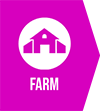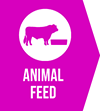Food challenges and solutions
It is estimated that between one fifth and one third of global greenhouse gas emissions are associated with food and drink.
The climate footprint of food is complex. As well as varying by food group, the way we produce, process, package and transport food all have an effect. Some examples of direct and indirect impacts across different food types are shown in the graphic below:
There is a vast difference in greenhouse gases that are produced across various food types:
 Above ground changes in biomass from deforestation and below ground changes in soil carbon.
Above ground changes in biomass from deforestation and below ground changes in soil carbon.
 Methane emissions from cows, methane from rice, emissions from fertilisers, manure and farm machinery.
Methane emissions from cows, methane from rice, emissions from fertilisers, manure and farm machinery.
 On farm emissions from crop production and its processing into feed for livestock
On farm emissions from crop production and its processing into feed for livestock
 Processing - Emissions from energy use in the process of converting raw agricultural products into final food items
Processing - Emissions from energy use in the process of converting raw agricultural products into final food items
 Emissions from energy use in the transport of food items in the country and internationally
Emissions from energy use in the transport of food items in the country and internationally
 Emissions from energy use in refrigeration and other retail processes
Emissions from energy use in refrigeration and other retail processes
 Emissions from the production of packaging materials, material transport and end-of-life disposal
Emissions from the production of packaging materials, material transport and end-of-life disposal
Most food related green-house gas (GHG) emissions are released in the production stage. This includes from land use change and on-farm processes such as the application of fertilisers (which releases nitrous oxide) and from grazing animals (which release methane).
Emissions also occur from transport, with air freight having the highest emissions and local, seasonal food potentially the lowest. However, some products transported long distances by boat can result in fewer emissions than locally produced animal products or out of season fresh produce and volume efficiency is also a factor.
For an average household of four, emissions resulting from food consumption was equivalent to almost double that of transport and heating emissions combined. For example, 12 tons for a meat-based diet, 4.6 tons for car use and 2.25 tons for gas central heating (The Independent, 2019).
An 'emissions hierarchy’ which details food product green-house gas emissions has been developed across different food categories as follows:
- Grains, fruit and vegetables have the lowest impact, followed by nuts and pulses.
- Chicken and pork (non-ruminant meat) have a medium impact.
- Fish also have a medium impact on average, however results between species varies significantly.
- Meat from beef and lamb (ruminant animals with multiple guts) have the highest impact.
(RMIT university, 2016)
Globally, we throw away around one third of the food we produce. Ten million tonnes of food and drink are wasted in the UK each year. This has a financial and environmental impact. A waste survey in Herefordshire in 2019, identified that the average household bin contains approx. 37% food waste, of which over half could have been composted.
The food waste hierarchy is a framework for the management of food surplus and food waste.
The solutions
National Sustainable Dietary Guidelines can impact our GHG emissions as well as improve our health, a healthy diet is also a sustainable diet.
Recommendations for achieving a sustainable diet:
- Aim to be food waste free - Meal planning, only buying what you need, purchasing wonky veg and using leftovers can all reduce our food waste
- Eat more plant based foods
- Eat less, but better quality, local meat and dairy
- Buy local, seasonal produce
- Support farmers markets and local box schemes
- Use local independent retailers
- Choose Fairtrade-certified products
- Select fish only from certified sustainable sources
- Eat a healthy balanced diet and eat less processed food
- Grow your own, join a community garden or food co-op
Larger organisations including the public sector can influence and support a change to a sustainable diet through policy and practice. For example, food and the environmental impact of agriculture must be considered in areas such as planning, and procurement should follow sustainable food guidelines, for example, school catering contracts, care homes and hospital food provision.
Locally the Herefordshire Food Alliance is a stakeholder group overseeing a co-ordinated, strategic approach to food across the county, including working towards a Sustainable food places award.

